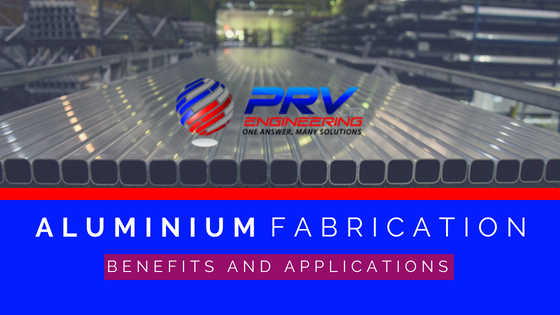
Several industries currently benefit from aluminium fabrication, which relates to the construction of metal structures by means of cutting, bending and joining. Most extrusions go through some form of further processes such as fabrication, machining and surface treatment. The properties of aluminium make extrusions highly suitable for almost any type of fabrication.
Although fabrication can be applied to any metal, aluminium is considered one of the most common. As a result, there is a big demand for aluminium fabrication services all over the world. If you look at your home or office building, aluminium is all around us. Some of the most common features are aluminium gates and aluminium frameworks used for doors, windows and showers.
Aluminium Fabrication Process and Benefits
Carrying out the process requires a variety of tools to join the different pieces together in a short space of time. In the extrusion design stage, optimised extrusions can minimise the need for further fabrication which means fitting and assembly may be more efficient. However, even if the extrusion’s properties and functions have been optimised, you often still require some fabrication.
We manufacture products in all materials from the most basic mild steels to the more exotic ones like Monnel, Inconnel, Hastalloy and Titanium. Aluminium fabrication is possible using most of the methods and equipment available for other materials. Our state-of-the-art machining centre can undertake fabrication up to 10 tonnes in single weight capacity for various applications.
Before starting an aluminium fabrication service, it is important to know the reason for selecting aluminium in the first place. Here are some of the benefits of using aluminium:
- Lightweight and durable
- Malleable and extremely ductile
- Resistant to any form of abrasion and corrosion
- Unaffected by magnetism
- Excellent conductor of heat and electricity
- Flexible to bend into any shape or form
As a result of these impressive characteristics, aluminium is more suitable for certain applications compared to other metals. Understanding the properties is essential to maximise your aluminium fabrication process.
Metal Finishing
Choosing an alloy is a critical decision in all aspects of the product development process. Each alloy has its own set of unique characteristics and properties. Aluminium gives the product suitable physical and mechanical properties while achieving an aesthetically pleasing appearance.
When treating the aluminium surface, it changes the properties and can improve corrosion resistance and mechanical wear. You can also achieve different finishes enhancing the decorative appeal in the final product.
Anodising
Anodising is an electrochemical process often used for protecting aluminium parts used in the manufacturing of military machinery and equipment. Here, the thickness of the naturally occurring oxide layer on the aluminium surface is artificially increased.
Similar to electroplating, the substrate is immersed in an electrolytic bath and connected to an electric current. The aluminium substrate serves as the anode (positively charged electrode), releasing oxygen ions from the bath. The oxygen ions combine with aluminium atoms fully integrated onto the surface of the substrate.
Powder Coating
Powder coating is a popular choice for insulating thick conductors, as well as those with multiple electrical contact points. This provides a durable protective layer which not only protects against corrosion, but carries good insulation ratings. Powder coating can be applied by electrostatic spray or fluid bath and then cured through a heat-shrink processes or UV light.
Profiles are pre-treated in order to clean and prepare the surface before going to the spray rooms. Here, the electro-statically charged powder is sprayed onto the face of the profiles to form an even coating. Once completed, it moves through a curing oven that melts the powder to form an even paint coating that adheres to the surface. Powder coating is very durable and also offers virtually unlimited choice of colours. Powder coated surfaces are more resistant to chipping, scratching, fading and wearing than other finishes.
Wet Coating
You could anodise or powder coat aluminium for roofing and cladding similar to extrusions although the preferred method is wet coating. It’s believe to be more cost effective to coat the material while in coil form. A number of polyester, acrylic and fluorocarbon coatings have been developed and successfully used for decorative and corrosion resistant surface finishes. While service life exceeds 20 years, these finishes come at premium price compared to mill finish.
Other methods of surface treatment include screen printing and the use of protective foils. Examples of mechanical surface treatments refer to mechanical brushing, polishing and barrel processing.
Applications of Aluminium Fabrication
While the various surface treatments of aluminium offer slightly different industry applications, we’ve compiled a combined list. It includes aluminium applications for anodising, powder coating and wet coating.
- Structural and architectural fabrication of all types – interior and exterior
- Commercial and residential building products including aluminium framework and aluminium gates
- Appliances and furniture, computer hardware, exhibition displays especially in retail
- Food preparation equipment
- Sporting goods and boats
- Components in motor vehiclesand aircraft
- Industrial piping
- Roofing, cladding and awnings
Although aluminium has good properties, sometimes the properties can make the fabrication process slightly difficult. As a result, it is crucial to find a reputable company capable of providing professional aluminium fabrication services.
Fabrication At PRV Engineering
Our vast industry knowledge and experience give our customers complete confidence in our abilities and total peace of mind. They know that we will expertly complete their installations and fabrication projects on time and within budget. To further improve customer service, we have our own plating facility and finishing department. It includes shot blasting rooms and cabinets, spray painting booths, wet spray room and a high bake oven.
Get in touch with the experts at PRV Engineering to get started on your project. including construction, automotive, aerospace, defence and rail among others.
This site uses Akismet to reduce spam. Learn how your comment data is processed.


 Mail:
Mail: 




Leave a Comments